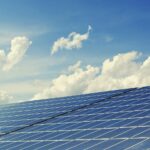Unveiling the Impact of Dust on Solar Panels
Solar panels, often seen as the gleaming flag bearers of renewable energy, have a nemesis lurking in the shadows. Yes, we’re talking about dust. Imagine you’ve got these brilliant energy converters on your roof. They’re gleaming, they’re efficient, but then – a layer of dust settles in. Suddenly, those efficient panels are not so efficient anymore. But how much of a hindrance is dust really?
Understanding Dust Composition and Origins
Dust isn’t just the tiny particles you see floating in a sunbeam. It’s a complex mix of pollen, pollutants, sand, organic materials, and more. Let’s dissect this a bit:
- Pollen: Often sticky, can be a pain to remove.
- Sand and Fine Dust: Usually found in desert regions. Abrasive and can cause wear.
- Organic Materials: Bird droppings, leaves, and other natural debris.
Ever wondered why desert installations suffer more? It’s not just the heat; the sand and fine dust play a pivotal role!
Quantifying the Impact: How Much Energy Do We Really Lose?
First things first, solar panels are built to withstand environmental challenges. However, the accumulation of dust is not something they can magically fend off. Studies show:
- A thin layer of dust can reduce panel efficiency by 5% to 25%.
- In desert areas, losses can even reach up to 40%!
Now, think about this. If you’re banking on solar energy for your power and there’s a 25% drop, that’s a significant loss, right?
Why Not Just Clean Them Regularly?
Sounds easy enough. However, there are some considerations:
- Water Scarcity: Especially in arid regions, using gallons of water isn’t viable.
- Maintenance Costs: Regular cleaning could lead to additional expenses.
- Safety Concerns: Not everyone’s comfortable climbing onto roofs.
To Brush or To Spray: Cleaning Techniques Explored
Cleaning is not just about grabbing a bucket of water and a sponge. You’ve got options:
- Dry Cleaning: Brushes and air blowers. Think of it as dusting your solar panels!
- Wet Cleaning: Water jets, detergents, and more.
Dry vs. Wet Cleaning
| Aspect | Dry Cleaning | Wet Cleaning |
|---|---|---|
| Water Usage | None | High |
| Efficiency | Moderate | High |
| Cost | Low | Moderate to High |
| Recommended For | Arid Areas | Humid Regions |
The Robo-Cleaners: Embracing Technology for Dust-Free Panels
Remember those robot vacuum cleaners that scuttle around your home? Imagine something similar for your solar panels. Automated cleaning robots are becoming a game-changer for large installations.
Benefits:
- No human intervention required.
- Consistent cleaning schedules.
- Reduced water usage in some models.
Prevention is Better than Cure: Protective Measures
Before you think about cleaning, how about stopping dust in its tracks? Possible solutions include:
- Coatings: Specialized coatings can repel dust to an extent.
- Tilt Angle: Adjusting the angle can help dust slide off.
- Placement: Avoid placing panels close to roads or dusty areas.
The Bigger Picture: Global Impact and Innovations
Dusty solar panels aren’t just a homeowner’s headache. On a global scale, we’re talking about massive energy losses. Innovations in the sector focus on:
- Dust prediction software.
- Improved panel coatings.
- Community-based cleaning initiatives.
The Environmental Dance: Dust and Weather Patterns
Weather plays a pivotal role in the rate of dust accumulation on solar panels. It’s a dance of elements, with each one influencing how much cleaning your solar panels might need.
Deserts and Arid Regions: Nature’s Sandblasters
It’s no secret that deserts are dusty places. But did you know that the constant winds, coupled with the barren landscape, act almost like nature’s sandblaster? Solar panels in these regions are in a constant battle, not only with the heat but with the relentless sandy gusts. The tiny sand particles can settle swiftly on panels, affecting their efficiency. Moreover, the occasional sandstorms can lead to a significant accumulation in a short span of time.
Tropical and Coastal Climates: Salty Concerns
On the other side of the spectrum are the tropical and coastal regions. While they might not have the dusty concerns of the deserts, they come with their own set of challenges. Humidity, coupled with the salty sea air, can lead to a different kind of residue on solar panels. This salt mist, while not blocking the sunlight as efficiently as dust, can still hinder the overall energy conversion process. Plus, the moist conditions can make this residue stickier and harder to clean.

Embracing The Future: Innovations in Dust-Resistant Solar Panels
The realm of solar technology isn’t just about harnessing more sunlight or creating more efficient cells. A significant part of the research now dives into making these panels more resilient, especially against dust.
Nano-Technology to the Rescue
Modern problems require futuristic solutions. One of the breakthroughs in recent times is the utilization of nanotechnology in creating protective layers for solar panels. These aren’t just any protective layers. Imagine a layer so sleek and smooth at the microscopic level that dust particles find it hard to stick. Even if they do, a gentle breeze or a light drizzle is often enough to wash them away.
Smart Panels: Self-Cleaning and More
Talk about smart technology, and solar panels are not far behind. The newest kids on the block are panels equipped with self-cleaning mechanisms. Think of tiny wipers, or vibrational systems that shake off the dust. Some even have minute nozzles incorporated that spray cleaning solutions, ensuring maximum efficiency round the clock. This might sound like something straight out of a sci-fi movie, but the reality is that the future of solar panels is not just brighter; it’s cleaner.
In Conclusion
Dusty solar panels might seem like a trivial concern. However, in the world of renewable energy, every bit counts. By understanding the issue and addressing it proactively, we can ensure that our solar panels perform at their peak. Whether it’s through robotic cleaners or simple preventive measures, a dust-free panel is a step towards a greener future.
Frequently Asked Questions
It depends on the region and dust accumulation. However, once every 3-6 months is a general recommendation.
While dust can reduce efficiency, it won’t damage the panels. However, abrasive materials like sand can cause wear over time.
For larger installations or if safety is a concern, professional cleaning can be beneficial.
Yes, several cleaning solutions are designed specifically for solar panels. They help in easy removal of sticky residues.
Good-quality coatings do not affect efficiency. In fact, they might enhance it by keeping the panels cleaner for longer.








